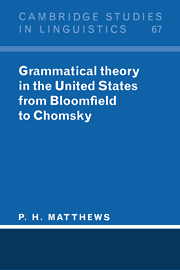2 - Bloomfield's morphology and its successors
Published online by Cambridge University Press: 10 December 2009
Summary
The concept of the morpheme is central to much of twentieth-century linguistics, and its history, especially in America, has been told before. But there are reasons for looking at it again. One is that, in interpreting the account in Bloomfield's Language, few commentators have made detailed reference to the earlier book, An Introduction to the Study of Language, which it replaced. But I will try to show that the comparison is interesting, for morphology and for grammatical theory generally. Another reason is that many have accepted far too readily the critique of Bloomfield's theory by American scholars since the 1940s. I will argue in §2.3 that it was in part mistaken, and that the weaknesses of his treatment, though real and serious, lay elsewhere. A third reason is that, although morphology was largely neglected in the heyday of generative phonology, a new chapter in its history began in the 1970s. I will therefore try to explore the connection between the work of the past twenty years and what had gone before. Finally, I would like to place the theory of the morpheme in what I believe to be its historical context. This can be seen as part of a wider tension or conflict, discernible sporadically throughout the century, between the concepts and techniques of grammar inherited from earlier Western traditions, and the doctrines or (if we prefer) the insights of structuralism.
In morphology, the tension lies particularly between two views of the status, or the primary locus, of grammatical categories.
- Type
- Chapter
- Information
- Grammatical Theory in the United StatesFrom Bloomfield to Chomsky, pp. 51 - 110Publisher: Cambridge University PressPrint publication year: 1993



